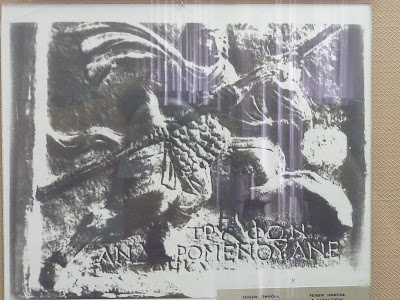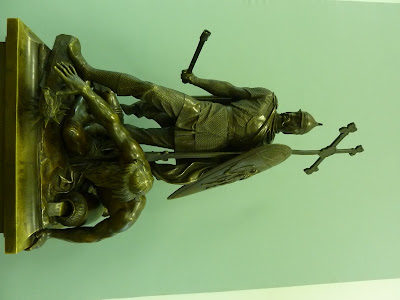I visited a few museums, 2 of which were particularly interesting, Ivan Honchar's Ukrainian Center of Folk Culture, and National History Museum of Ukraine. I have some pictures taken at these museum. I will only post a few that I think are of the most interesting ones.
Ukrainian Center of Folk Culture
Meseum Entrance
Meseum Entrance
A new couple. Unsure when this was taken. Sergei says definitely after photos and cameras were invented. Let's hope he is right. But notice the broom is in suit. The bride is in traditional costume. Not many cultures today retain the colorful costumes. Pity.
Traditional musical instruments and swords. What a combination, you might ask. The cossaks, living horse backs, classically carry both of these with them. Cossak, a social class or profession, one who is independent and a professional soldier, per my understanding quite like a samurai of the feudal Japan, and a knight of medieval (western) Europe,
Zoom on the swords. There are also smoke pipes on one end. Another typical companion of cossaks in the past.
Cossaks.
a cossak community.
Another new couple. Now both are in traditional dressing. Nice!
Ivan Honchar himself. An artist, a sculptor, and a painter. The museum is build upon his private collection, since his death in 1993.
Cossaks.
Ukrainian women in costume. Beautiful.
A bride?
Me signing the Museum guest book. The sculptor in uniform in the picture on the wall, is Ivan. If I ever wish to contribute to my own culture, I would wish to be like him. And being in Soviet Russia, trying to preserve the minority Ukrainian culture isn't particularly something KGB encourages. Something extraordinary an ordinary man can do. Salute, Ivan.
National History Museum of Ukraine
Scythian people and culture
Daggers, spear heads and armor of the Scythian.
Scythian territory. Scythians are nomads, an Iranian people. The Scythians established kingdoms here a few hundred BC.
A Greek soldier
Greek.
Sarmatian, another Iranian people. From 5th BC to 4th AD, they spanned mostly in the west Scythia.
I am sure this is not about the ancient Ukrainian hair styles. I wish I remembered this one. Must be something interesting. Never been a good note taker.
Khazars. A Turkic people, among many others, have once occupied area around Caucasus, between Black Sea and Caspian Sea. Their time is from 7th - 10th century. At the peak time, they drove a branch of the old Bulgars to today's Bulgaria; blocked the Islamic invasion from the south, in a way historically draw the border of the religions.
Khazars. Eventually the Khazars were over powered and subjugated to the Kievan Rus.
Armor of the Khazars.
This looks much closer to today's Ukrainian style, so must be the Slavic part of the history.
Some battle against the Tartars.
This is one of the princes at the Kievan time. Just forgot who. The fact that there is a cross, I suspect it is Prince Vladimir, who introduced Christianity to the then pagan Kievan Rus, and baptized the princedom. This happened at the end of 10th century.
A wooden wagon.
Military uniform. Completely Russian style. Suspect the Tsar's army.
This looks very Russian to me, except for the long scarf hanging on the wall at the back.
It looks to me this mixed in a little nomad's style, from the 2 piece setting to the cut of the shirt. The area has to constant deal with invasions from the nomads from the east, sometimes defeated and devastated by the horse back people, from as early as the prehistoric time. It shouldn't be impossible for the traditional costumes to show some of the foreign traits.
The pattern is very Ukrainian. It couldn't be anything else.
The setting of a typical Ukrainian peasant's house and yard/
A shot from the back of the yard.







































No comments:
Post a Comment